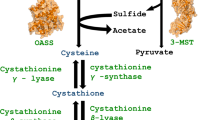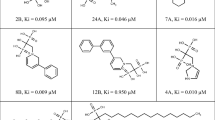Abstract
Leishmaniasis is caused by several protozoa species belonging to genus Leishmania that are hosted by humans and other mammals. Millions of new cases are recorded every year and the drugs available on the market do not show satisfactory efficacy and safety. A hierarchical virtual screening approach based on the pharmacophore model, molecular docking, and molecular dynamics was conducted to identify possible Leishmania braziliensis N-misristoyltransferase (LbNMT) inhibitors. The adopted pharmacophore model had three main features: four hydrophobic centers, four hydrogen-bond acceptor atoms, and one positive nitrogen center. The molecules (n=15,000) were submitted to alignment with the pharmacophore model and only 27 molecules aligned to model. Six molecules were submitted to molecular docking, using receptor PDB ID 5A27. After docking, the ZINC35426134 was a top-ranked molecule (− 64.61 kcal/mol). The molecule ZINC35426134 shows hydrophobic interactions with Phe82, Tyr209, Val370, and Leu391 and hydrogen bonds with Asn159, Tyr318, and Val370. Molecular dynamics simulations were performed with the protein in its APO and HOLO forms for 37 ns in order to assess the stability of the protein–ligand complex. Results showed that the HOLO form was more stable than the APO one, and it suggests that the ZINC35426134 binding stabilizes the enzyme. Therefore, the selected molecule has the potential to meet the herein proposed target.








Similar content being viewed by others
References
Velasquez AMA et al (2017) Efficacy of a binuclear cyclopalladated compound therapy for cutaneous leishmaniasis in the murine model of infection with Leishmania amazonensis and its inhibitory effect on Topoisomerase 1B. Antimicrob Agents Chemother 61(8):1–15
Espada RC et al (2017) Susceptibility to miltefosine in Brazilian clinical isolates of Leishmania (Viannia) braziliensis. Am Soc Trop Med Hyg 96(3):656–659
Osório E et al (2005) Leishmania: papel de la glicoproteína P en la mediación de resistencia a medicamentos y estrategias de reversión. Biomédica 25(2):242–260
Hutton JA (2014) Structure-based Design of Potent and Selective Leishmania N-Myristoyltransferase inhibitors. J Med Chem 57(20):8664–8670
Resh MD (2012) Targeting protein lipidation in disease. Trends Mol Med 18(4):206–214
Herrera LJ et al (2016) Validation of N-myristoyltransferase as Potential Chemotherapeutical target in Mammal-Dwelling Stages of Trypanosoma cruzi. Negl Trop Dis 10(4):1–20
Guido RCV, Oliva G, Andricopulo AD (2008) Virtual screening and its integration with modern drug design technologies. Curr Med Chem 15:37–46
Kumar A, Zhang KYJ (2014) Hierarchical virtual screening approaches in small molecule drug. Methods 71:26–37
Harvey AL, Edrada-ebel R, Quinn RJ (2015) The re-emergence of natural products for drug discovery in the genomics era. Nat Rev 14(2):111–129
Rackhan MD et al (2015) Discovery of high affinity inhibitors of Leishmania donovani N-myristoyltransferase. MedChemComm 6:1761–1766
Paz O (2012) Estudos de QSAR 2D e QSAR 3D para um conjunto de antagonistas de receptores de adenosina 2b, potencialmente úteis no tratamento da anemia falciforme. Dissertação (Mestrado em Biotecnologia) – Programa de Pós-Graduação em Biotecnologia, Universidade Estadual de Feira de Santana, Feira de Santana
Chemaxon (2015) Marvin Sketch 6.0.1
Pettersen EF et al (2004) UCSF chimera—a visualization system for exploratory research and analysis. J Comput Chem 25(13):1605–1612
Clark M, Cramer RD, Opdenbosch NV (1989) Validation of the general purpose tripos 5.2 force field. J Comput Chem 10(9):982–1012
Mysinger MM et al (2012) Directory of useful decoys. Enhanced (DUD-E): better ligands and decoys for better benchmarking. J Med Chem 55(14):6582-6594
Lätti S, Niinivehmas S, Pentikäinen OT (2016) Rocker: open source, easy-to-use tool for AUC and enrichment calculations and ROC visualization. J Cheminform 8:45
Sievers F et al (2011) Fast, scalable generation of high-quality protein multiple sequence alignments using Clustal omega. Mol Syst Biol 7(539):1–6
Gordon JC et al (2005) H++: a server for estimating pKa's and adding missing hydrogens to macromolecules. Nucleic Acids Res 33:368–371
Branning JA (2010) N-myristoyltransferase from Leishmania donovani: structural and functional characterisation of a potential drug target for visceral leishmaniasis. J Mol Biol 396(4):985–999
Montanari CA (2011) Química Medicinal: Métodos e fundamentos em planejamento de fármacos. 1 ed. São Paulo: Edusp,732 p
Trott O, Olson AJ (2010) AutoDock Vina: improving the speed and accuracy of docking with a new scoring function, efficient optimization and multithreading. J Comput Chem 31:455–461
Lang P et al (2017) Dock 6.8 Users Manual
Jones G et al (1997) Development and validation of a genetic algorithm for flexible docking. J Mol Biol 267:727–748
Ewing TJA et al (2001) DOCK 4.0: search strategies for automated molecular docking of flexible molecule databases. J Comput Aided Mol Des 15:411–428
Jiang L, Rizzo RC (2015) Pharmacophore-based similarity scoring for DOCK. J Phys Chem B 119(3):1083–1102
Korb O, Stützle T, Exner TE (2009) Empirical scoring functions for advanced protein–ligand docking with PLANTS. J Chem Inf Model 49:84–96
Mantsyzov AB et al (2012) Contact-based ligand-clustering approach for the identification of active compounds in virtual screening. Adv Appl Bioinforma Chem 5:561–579
Junier T, Zdobnov EM (2010) The Newick utilities: high-throughput phylogenetic tree processing in the UNIX shell. Bioinformatics 26:1669–1670
Salentin S et al (2015) PLIP: fully automated protein–ligand interaction profiler. Nucl Acids Res 43(1):443–447
Rostkowski M et al (2011) Graphical analysis of pH-dependent properties of proteins predicted using PROPKA. BMC Struct Biol 11(1):6
Schuttelkopf AW, Van Aalten DMF (2004) PRODRG: a tool for high-throughput crystallography of protein–ligand complexes. Acta Crystallogr D Biol Crystallogr 60(8):1355–1363
Gereben O, PUSZTAI L (2011) On the accurate calculation of the dielectric constant from molecular dynamics simulations: the case of SPC/E and SWM4-DP water. Chem Phys Lett 507:80–83
Patel CN et al (2017) Pharmacophore-based virtual screening of catechol-o-methyltransferase (COMT) inhibitors to combat Alzheimer’s disease. J Biomol Struct Dyn 13(10):1–20
Turner PJ (1991) Grace-5.1.22/qtGrace v 0.2.4, Available at <http://plasma-gate.weizmann.ac.il/Grace/>. Accessed January 5, 2018
Dorfman RJ et al (2008) A knowledge-based approach to generating diverse but energetically representative ensembles of ligand conformers. J Comput Aided Mol Des 22:681–691
Xie H, Qiu K, Xiaoguang X (2014) 3D QSAR studies, pharmacophore modeling and virtual screening on a series of steroidal aromatase inhibitors. Int J Mol Sci 15(20):927–947
Caballero J (2010) 3D-QSAR (CoMFA and CoMSIA) and pharmacophore (GALAHAD) studies on the differential inhibition of aldose reductase by flavonoid compounds. J Mol Graph Model 29(3):363–371
Rang HP et al (2016) Farmacologia: Rang & Dale, 8th edn. Elsevier, Rio de Janeiro, p 1939
Proverbio D et al (2013) Comparison of a clinic-based ELISA test kit with the immunofluorescence antibody test for assaying Leishmania infantum antibodies in dogs. Biomed Res Int 1-6
Kulkarni SS, Kulkarni VM (1999) Three-dimensional quantitative structure–activity relationship of interleukin 1-beta converting enzyme inhibitors: a comparative molecular field analysis study. J Med Chem 42(3):373–380
Sogabe S et al (2002) Crystal structures of Candida albicans N-myristoyltransferase with two distinct inhibitors. Chem Biol 9(10):1119–1128
Karki RG, Kulkarni VM (2001) A feature based pharmacophore for Candida albicans Myristoyl-CoA: protein N-myristoyltransferase inhibitors. Eur J Med Chem 36:147–163
Vyas VK et al (2015) Ligand and structure-based approaches for the identification of SIRT1 activators. Chemico-Biological Interactions, p 1-9
Tirera S et al (2017) Unraveling the genetic diversity and phylogeny of Leishmania RNA virus 1 strains of infectedLeishmania isolates circulating in French Guiana. PLoS Negl Trop Dis 11(7):e0005764
Umunnakwe CN et al (2017) Identification of a homogenous structural basis for oligomerization by retroviral rev-like proteins. Retrovirology 14:40
Trott O, OLSON AJ (2010) AutoDock Vina: improving the speed and accuracy of docking with a new scoring function, efficient optimization and multithreading. J Comput Chem 31:455–461
Verli H (2014) Dinâmica Molecular. In: VERLI, H. Bioinformática: da Biologia à Flexibilidade Molecular. 1. ed. - São Paulo: SBBq, p 173-187
Kumar R, Indrayan A (2011) Receiver operating characteristic (ROC) curve for medical researchers. Indian Pediatr 48:277–289
Rastrebo-Escobar M, Granda-Carvajal P, JAIMES F (2017) Development and Internal Validation of a Prediction Model to Estimate the Probability of Needing Aggressive Immunosuppressive Therapy With Cytostatics in de Novo Lupus Nephritis Patients. Reumatología Clínica
Robinson DA, Wyatt PG (2015) Pharmacophore-based similarity scoring for DOCK. Acta Cryst 71:586–593
Tavares MT (2015) Interações fármaco-receptor: aplicações de técnicas computacionais em aula prática sobre a evolução dos inibidores da enzima conversora de angiotensina. Química Nova 38(8):1117–1124
Sheng C et al (2009) Homology modeling and molecular dynamics simulation of N-myristoyltransferase from protozoan parasites: active site characterization and insights into rational inhibitor design. J Comput Aided Mol Des 23:375–389
Paul P et al (2015) Homology modeling and molecular dynamics simulation of N-myristoyltransferase from Plasmodium falciparum: an insight into novel antimalarial drug design. J Mol Model 21:1–37
Borges NM (2018) Similarity search combined with docking and molecular dynamics for novel hAChE inhibitor scaffolds. J Mol Model 24-41:1–12
Tsai CJ, Del Sol A, Nussinov R (2009) Protein allostery, signal transmission and dynamics: a classification scheme of allosteric mechanisms. Mol BioSyst 5(3):207–216
Acknowledgements
The authors would like to thank Fundação de Amparo à Pesquisa do Estado da Bahia (FAPESB) and Programa de Pós-Graduação em Ciências Farmacêuticas - Universidade Estadual de Feira de Santana-BA.
Author information
Authors and Affiliations
Corresponding author
Additional information
This paper belongs to Topical Collection XIX - Brazilian Symposium of Theoretical Chemistry (SBQT2017)
Rights and permissions
About this article
Cite this article
de Carvalho Gallo, J.C., de Mattos Oliveira, L., Araújo, J.S.C. et al. Virtual screening to identify Leishmania braziliensis N-myristoyltransferase inhibitors: pharmacophore models, docking, and molecular dynamics. J Mol Model 24, 260 (2018). https://doi.org/10.1007/s00894-018-3791-8
Received:
Accepted:
Published:
DOI: https://doi.org/10.1007/s00894-018-3791-8




